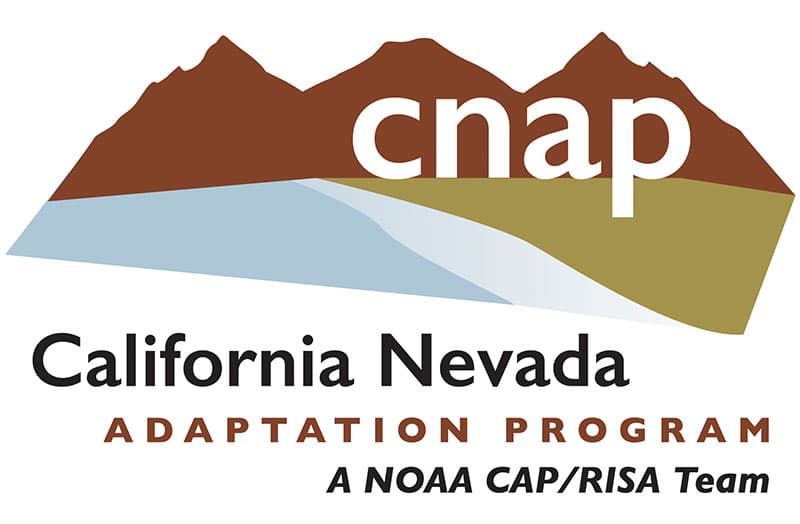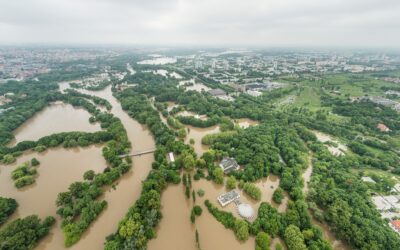DRI is partnering with Scripps Institution of Oceanography to build climate resiliency through the California Nevada Adaptation Program (CNAP)
The impacts of climate change have been acute in California and Nevada, with most of the last two decades spent in extended drought conditions and 2021 wildfires producing Reno’s worst recorded air quality in the 21st century. Adapting to these challenges will require not only focused research to better predict climatic events, but will also depend on empowering local communities to use this knowledge to make informed decisions in the face of adversity. With $5 million in funding from NOAA’s Climate Adaptation Partners initiative, the California Nevada Adaptation Program (CNAP) will spend the next five years bringing together researchers, community members, and practitioners to cooperatively conduct research and identify solutions.
For the first time, CNAP will be hosted in Nevada under the leadership of DRI’s Tamara Wall, Ph.D., research professor of atmospheric science and deputy director of the Western Regional Climate Center (WRCC). DRI’s long-standing partnership with Scripps Institution of Oceanography at the University of California San Diego will continue, with Dan Cayan, Ph.D., regional climate researcher and CNAP lead since its founding in 1999, and Julie Kalansky, Ph.D., who has served as CNAP program manager for six years, joining Wall to lead the project.
“The goal of CNAP has always been to expand more fully across the California and Nevada region,” Wall says. “This is the first time that DRI is leading CNAP, and it’s also the first time that CNAP is a system-wide effort. Bringing on partners from UNLV and UNR is important for meeting that goal and will help us address climate change impacts across the state.”
California and Nevada have partnered for the CNAP program since 2011, producing research and results that include: the first Nevada Climate Assessment; California’s Fourth Climate Change Assessment; recommendations for updating red flag warnings and the fire weather watch system; and analyses of water use and supply in California’s agricultural communities.
The next five years will focus on adaptation, with an intentional transition from statewide climate research toward preparing communities for local-level action to address regional climate hazards. Six projects will support adaptation needs to address four of the most pressing climate issues in the region: extreme heat, wildfire smoke, coastal flooding, and water scarcity. As part of the project’s commitment to equity and diversity, it will include a mentorship program within community colleges to prepare the future’s workforce to address climate impacts. In addition, a small grants program, Building Capacity through Reciprocity with Tribal Communities, will work to enact community-identified solutions for tribal communities by supporting a Leaders Indigenous Climate Fellowship Program.
“Centering CNAP’s research on adaptation allows us to focus on producing community-centered solutions,” Wall says. “Impacts from climate change are expected to amplify in the coming decades, and disadvantaged communities are the least able to manage those impacts without additional support. Our research includes community partners so that we can adequately understand community needs and concerns and actually improve people’s lives.”
Research Focus Areas
Extreme Heat
Highlights for planned research include creating the Southern Nevada Heat Resilience Lab (SNHRL), a regionally focused program that will bring together public service providers, including emergency responders and social services workers, with scientific experts on extreme heat. Real-time air temperature sensors will be installed in at-risk neighborhoods within Las Vegas, targeting locations such as public transit stops and buses, cooling centers, places with outdoor laborers, and unhoused communities. Following a trial period in Las Vegas, the project aims to expand local heat sensor networks to rural and Indigenous communities, where heat impacts are less well studied and understood
Water Resiliency
In order to help California prepare a more resilient workforce in the face of growing issues with water availability, CNAP will partner with community colleges in the San Joaquin Valley to create climate-related workforce training opportunities. The goal is to create a more climate-technical workforce to support community adaptation to changes in water availability and climate extremes.
Coastal Erosion
Southern California is lined with some of the most heavily used beaches on the West coast, and this region is likely to experience increased flooding and erosion due to sea-level rise. CNAP will partner with collaborators to explore nature-based solutions and Indigenous stewardship as coastal adaptation strategies.
Public Health in the Face of Extreme Heat and Wildfire Smoke
California and Northern Nevada are increasingly experiencing extreme weather conditions with overlapping heat waves and intense wildfires. CNAP will explore the public health impacts of these events by directly assessing a sample of households in Washoe County, Nevada. Research will include installing air sensors to monitor heat exposure and air pollution, conducting interviews to understand decision-making under environmentally challenging conditions, and baseline health monitoring.
Understanding Burnout in Climate Change Professionals
Previous CNAP research has shown that climate change professionals are experiencing high rates of burnout, and institutional support isn’t yet providing adequate resources to this population. CNAP will continue this line of study by evaluating the traits and communities that lead to more psychological resiliency and developing training materials based on the results for the CNAP team and partner networks.
State Climate Assessments
Both California and Nevada will likely produce new statewide climate assessments within the next five years, and CNAP will continue to coordinate among state and local efforts. CNAP will also pilot a mentoring program focused on early career faculty at universities and colleges in California and Nevada.
“NOAA Climate Adaptation Partnerships (CAP, formerly ‘RISA’) advances equitable adaptation through sustained regional research and community engagement,” says Caitlin Simpson, Program Manager, NOAA Climate Adaptation Partnerships. “Climate affects every part of society, and this is most visible to us when we see long-term changes in social and environmental conditions, increased unpredictability, and extreme weather events. We seek to help people plan for and adjust to a changing climate by supporting long-lasting partnerships among scientists, decision makers, and communities. The result is a shared understanding about society’s needs and the co-generation of credible and actionable knowledge to support community solutions. We work within regions composed of multiple US state/territory jurisdictions which share similar climates and cultures.”
“CNAP’s long history in the CAP/RISA program dates from 1997, and features many accomplishments, including substantial scientific contributions to all five of California’s climate assessments in close partnership with the state government. CNAP has achieved deep expertise on sea level rise, drought, water resources, and wildfire planning issues and has closely partnered with a number of federal and nonfederal partners to advance local, state, and regional planning around these issues. The NOAA Climate Program Office is thrilled to fund the California-Nevada Climate Applications Program (CNAP) team for another five years as a part of the CAP/RISA Network.”

More information:
For additional information about CNAP visit: https://www.dri.edu/cnap/
CNAP Principal Investigators include Tamara Wall (DRI), Julie Kalansky (Scripps), and Daniel Cayan (Scripps).
###
About DRI
The Desert Research Institute (DRI) is a recognized world leader in basic and applied environmental research. Committed to scientific excellence and integrity, DRI faculty, students who work alongside them, and staff have developed scientific knowledge and innovative technologies in research projects around the globe. Since 1959, DRI’s research has advanced scientific knowledge on topics ranging from humans’ impact on the environment to the environment’s impact on humans. DRI’s impactful science and inspiring solutions support Nevada’s diverse economy, provide science-based educational opportunities, and inform policymakers, business leaders, and community members. With campuses in Las Vegas and Reno, DRI serves as the non-profit research arm of the Nevada System of Higher Education. For more information, please visit www.dri.edu.


